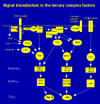 |
About Our Lab - a Brief History |
 |
 |
About Our Lab - a Brief History |
 |
 The Lab is housed on the fourth floor of the Queen's Medical Centre. The
windows have a southern aspect, offering splendid views that range from
Radcliffe on Soar power station away in the west (which, thanks to its
scrubbers, generates acid-free clouds) to Nottingham Castle, squat on its
hill to the east, with the River Trent, partially visible, meandering murkily
between them.
The Lab is housed on the fourth floor of the Queen's Medical Centre. The
windows have a southern aspect, offering splendid views that range from
Radcliffe on Soar power station away in the west (which, thanks to its
scrubbers, generates acid-free clouds) to Nottingham Castle, squat on its
hill to the east, with the River Trent, partially visible, meandering murkily
between them.
The city, spread out behind the castle, offers major attractions that
allow Nottingham University to proclaim itself to be the most popular University
in Britain: about fifty nightclubs, including Rock City, whose fame had
reached even Freiburg along with Robin Hood's. Then there is Trent Bridge
for the sporting connoisseurs and the City Ground for sporting masochists.
 Somewhat to Mike Greenberg's chagrin, the baton was taken on by Richard
Treisman who succeeded, almost single-handedly, in mapping the Serum
Response Element (SRE) within the c-fos promoter and then identifying,
purifying and cloning the Serum
Response Factor (SRF), which binds to the SRE. SRF apears to be another
saddle on the DNA, like the TATA-box Binding Protein (TBP). It even bends
the SRE, which has an A/T rich core, albeit it in the opposite way to TBP.
Somewhat to Mike Greenberg's chagrin, the baton was taken on by Richard
Treisman who succeeded, almost single-handedly, in mapping the Serum
Response Element (SRE) within the c-fos promoter and then identifying,
purifying and cloning the Serum
Response Factor (SRF), which binds to the SRE. SRF apears to be another
saddle on the DNA, like the TATA-box Binding Protein (TBP). It even bends
the SRE, which has an A/T rich core, albeit it in the opposite way to TBP.
 At least one rider is known to sit on this saddle. It was identified initially
as a 62kd polypeptide and was originally referred to as the ternary complex
factor (p62TCF). TCF is probably a heterogeneous
activity in most cells and in fact, to date, three genes have been identified,
one way or another, that encode TCFs: Elk-1, Sap1a and Net/Erp/Sap2. The
proteins are closely related and belong to the ets family of transcription
factors.
At least one rider is known to sit on this saddle. It was identified initially
as a 62kd polypeptide and was originally referred to as the ternary complex
factor (p62TCF). TCF is probably a heterogeneous
activity in most cells and in fact, to date, three genes have been identified,
one way or another, that encode TCFs: Elk-1, Sap1a and Net/Erp/Sap2. The
proteins are closely related and belong to the ets family of transcription
factors.
![]() Ever since we found that out the Lab has been mildly schizophrenic as we tried
to dance at two weddings. Anyway, the carboxy-terminal domain of Elk-1 (or Sap1a,
or Net/Erp/Sap2 for that matter) is multiply phosphorylated by ERK1 and ERK2
in response to mitogenic signals, and by SAPK/JNKs and probably even p38mapk
in response to noxious agents and cellular stress [for
more information see Jim Woodgett's page].
Ever since we found that out the Lab has been mildly schizophrenic as we tried
to dance at two weddings. Anyway, the carboxy-terminal domain of Elk-1 (or Sap1a,
or Net/Erp/Sap2 for that matter) is multiply phosphorylated by ERK1 and ERK2
in response to mitogenic signals, and by SAPK/JNKs and probably even p38mapk
in response to noxious agents and cellular stress [for
more information see Jim Woodgett's page].
 So besides continuing to try and understand how TCFs actually get RNA polII
rolling off the c-fos promoter once they become activated, we have
also aimed to chart some of the pathways
from the many agonists that influence TCFs. One of the approaches we have
taken is to adapt TCFs so that various upstream signalling events can be
monitored specifically and selectively.
So besides continuing to try and understand how TCFs actually get RNA polII
rolling off the c-fos promoter once they become activated, we have
also aimed to chart some of the pathways
from the many agonists that influence TCFs. One of the approaches we have
taken is to adapt TCFs so that various upstream signalling events can be
monitored specifically and selectively.
|
|

Peter Shaw
Email: Peter.Shaw@nottingham.ac.uk
|